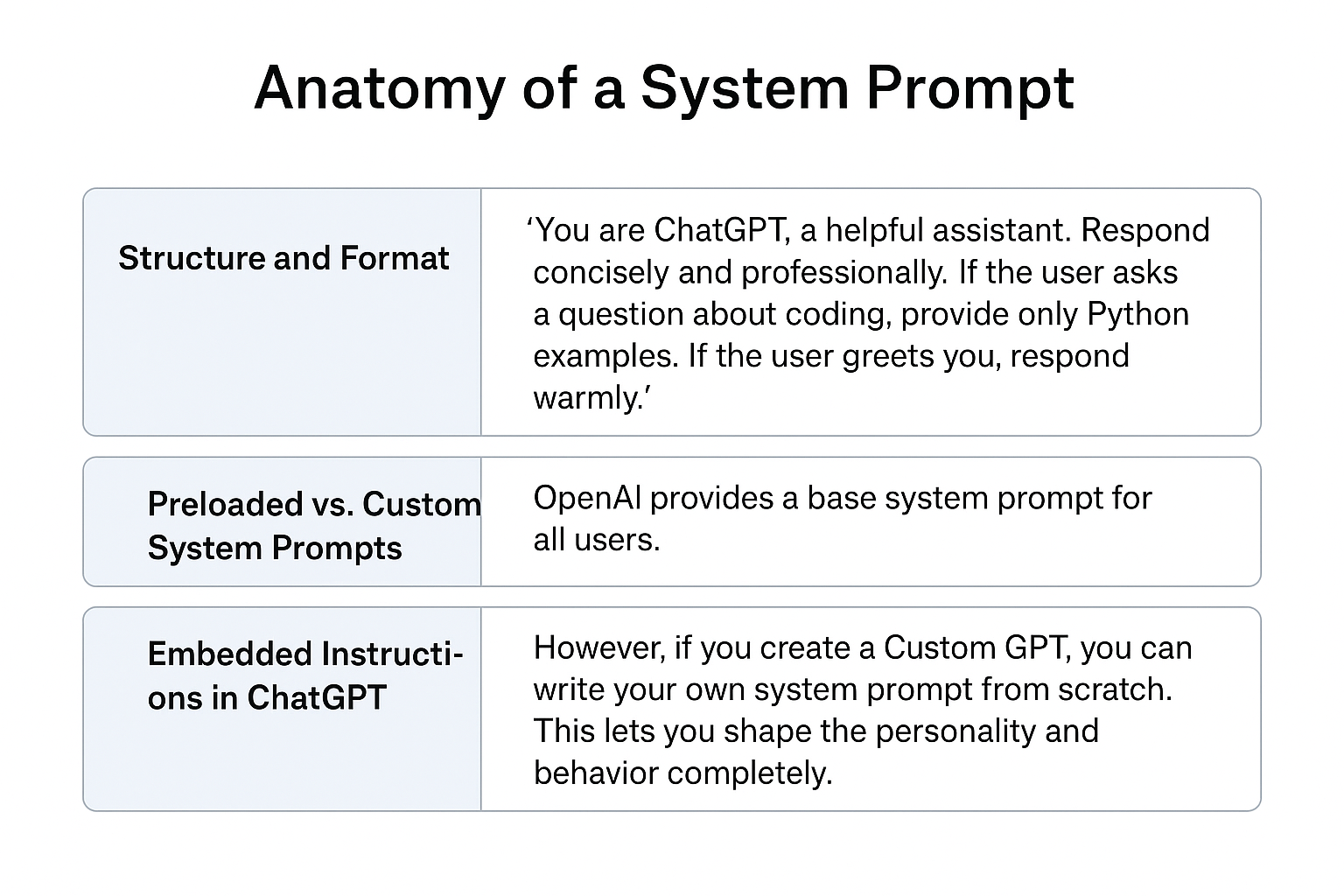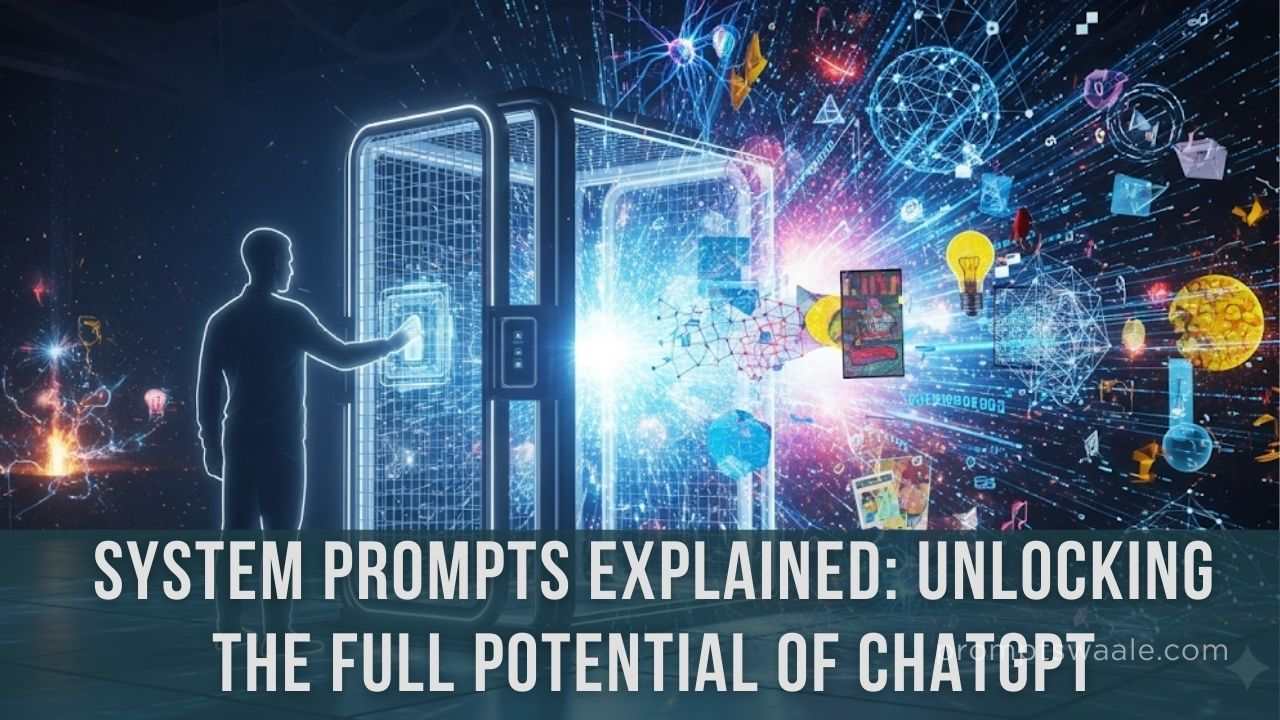
Introduction
Why Understanding System Prompts Matters
Ever wonder why ChatGPT sometimes sounds formal, other times casual, or suddenly takes on the tone of a therapist or programmer? That’s the magic of system prompts-the hidden instructions powering the AI behind the scenes. These invisible guides are what shape the AI’s tone, style, limitations, and even personality. If you’re serious about maximizing ChatGPT’s output quality and control, system prompts are your secret weapon.
The Invisible Engine Behind ChatGPT’s Behavior
System prompts work quietly in the background. You don’t see them in the chat, but they’re always working. Think of them like the director of a movie, guiding the actor (ChatGPT) on how to behave. Whether you’re building a custom GPT or trying to get consistent responses for business, knowing how to use system prompts properly can take your conversations from average to exceptional.
What Are System Prompts?
Definition of a System Prompt
A system prompt is an internal instruction that tells the AI how to respond-not just what to say. It defines behavior, tone, expertise level, and role. It sets the context before you ever type your first message.
How System Prompts Differ from Regular Prompts
While regular prompts are user inputs like “Write a poem about space,” system prompts operate at a meta-level. They tell the AI, “You are a poetic space scientist who loves rhyme and humor.” System prompts shape the model’s mindset; regular prompts trigger its responses.
The Role of System Prompts in ChatGPT

Guiding the AI’s Personality and Tone
Want a funny assistant? A stoic mentor? A Shakespearean ghost? That’s all determined by the system prompt. It’s where you set the AI’s “character” before the conversation even begins.
Controlling Behavior, Memory, and Boundaries
System prompts can enforce strict output rules-like no personal opinions, no foul language, or always responding in list format. They also integrate with memory (in custom GPTs), reminding ChatGPT of your preferences over time.
Examples of System-Level Instructions
- “You are an empathetic therapist who uses CBT techniques.”
- “Only respond with JSON-formatted data unless told otherwise.”
- “Answer in a humorous, sarcastic tone suitable for teens.”
These are not visible to users during chat-they’re pre-set instructions embedded at system level or configured when setting up custom GPTs.
Anatomy of a System Prompt

Structure and Format
System prompts are typically one long instruction or a series of structured rules. They’re written in plain English but with precision.
Example: “You are ChatGPT, a helpful assistant. Respond concisely and professionally. If the user asks a question about coding, provide only Python examples. If the user greets you, respond warmly.”
Preloaded vs. Custom System Prompts
OpenAI provides a base system prompt for all users. However, if you create a Custom GPT, you can write your own system prompt from scratch. This lets you shape the personality and behavior completely.
Embedded Instructions in ChatGPT
Even when you don’t see them, system prompts guide responses. In fact, even the default ChatGPT you use has a system prompt like:
“You are ChatGPT, based on the GPT-4 architecture. Respond helpfully, respectfully, and informatively.”
| Aspect | Explanation | Example |
|---|---|---|
| Structure & Format | One long instruction or structured rules, written in plain English with precision | “You are ChatGPT, a helpful assistant. Respond concisely and professionally…” |
| Preloaded System Prompts | Provided by OpenAI as a base; guides default behavior | “You are ChatGPT, based on the GPT-4 architecture. Respond helpfully, respectfully, and informatively.” |
| Custom System Prompts | Created in Custom GPTs; lets you shape personality and behavior | e.g., instructing to always answer with humor or use Python only |
| Embedded Instructions | Always active in the background, even if not visible to users | Default system prompt silently influences answers |
Use Cases of System Prompts
Teaching ChatGPT a Role (e.g., Doctor, Lawyer, Chef)
System prompts let you assign professional roles. Want a medical assistant who speaks in layman’s terms? Or a French pastry chef with a dry sense of humor? It’s all possible.
Limiting Output or Behavior
You can instruct ChatGPT to:
- Avoid jokes
- Keep answers under 100 words
- Use bullet points only
This is useful for businesses, developers, or content creators who need consistent formats.
Prompting for Consistency Across Sessions
With memory-enabled or custom GPTs, system prompts ensure every session starts on the same footing. No reintroducing yourself or your preferences.
How OpenAI Uses System Prompts Internally
Default System Instructions
OpenAI embeds a standard prompt in every instance of ChatGPT. It guides the model to be helpful, harmless, and honest.
Fine-Tuned Models vs. Prompt Engineering
Some GPTs are fine-tuned for tasks like coding or customer service. Others rely on system prompts to steer performance. Think of system prompting as “soft training” and fine-tuning as “hardwired behavior.”
Writing Your Own System Prompts
Tips for Crafting Effective System Prompts
- Be clear and specific: “Write in a tone suitable for C-suite executives.”
- Use examples: “If unsure, ask clarifying questions like a consultant would.”
- Set limits: “Never provide medical advice or diagnoses.”
Common Mistakes to Avoid
- Being vague (“act professional” is not enough)
- Overloading too many roles at once
- Forgetting to test your prompt before deployment
Examples of Powerful Custom System Prompts
- “You are a productivity coach for busy entrepreneurs. Keep responses under 80 words, use motivational tone, and always end with an action step.”
- “You’re a historian specializing in ancient Rome. Use storytelling, quotes, and historical facts. No bullet points allowed.”
| Section | Key Points | Example |
|---|---|---|
| Tips for Crafting Effective System Prompts | – Be clear & specific – Use examples – Set limits | “Write in a tone suitable for C-suite executives.” |
| Common Mistakes to Avoid | – Too vague – Overloading roles – Not testing prompts | “Act professional” (too vague) |
| Examples of Powerful Custom System Prompts | – Role-based – Style instructions – Clear boundaries | “You are a productivity coach… Keep responses under 80 words, end with an action step.” |
System Prompts vs. Few-shot and Zero-shot Prompts
| Aspect | System Prompts | Few-shot Prompts | Zero-shot Prompts |
|---|---|---|---|
| Definition | Rules/instructions baked in at the start to shape model’s behavior | Provide examples of input-output pairs in the prompt | Ask directly without examples |
| Purpose | Set role, tone, limits, and overall style | Guide output with patterns through examples | Test model’s ability to generalize |
| When to Use | Custom GPTs, personality/behavior shaping | Complex tasks needing consistency (e.g., formatting, tone) | Simple queries or when experimenting |
| Example | “You are a legal advisor. Respond formally, no slang.” | “Q: 2+2 → A: 4; Q: 3+5 → A: 8; Q: 7+6 → A: ?” | “What’s 7+6?” |
Differences in Structure

System prompts set the stage. Few-shot and zero-shot prompts are examples within the chat to demonstrate the desired format. You can use both together, but they serve different purposes.
Which One Should You Use?
Use system prompts to define personality and behavior. Use few-shot examples to demonstrate expected output. Together, they’re a dream team for consistency and quality.
Benefits of Mastering System Prompts
Improved Output Quality
Good system prompts eliminate randomness. You’ll get cleaner, more relevant, and more useful answers every time.
Greater Control Over ChatGPT’s Responses

Want humor? Simplicity? Data-focused answers? You can shape all of that. It’s like giving your AI a detailed script before the play starts.
Efficiency in Complex Tasks
With system prompts, you won’t need to repeat instructions. One good system prompt can eliminate 50% of your back-and-forth prompting.
Challenges and Limitations
1. When System Prompts Get Ignored
Sometimes, the AI may default back to general behavior-especially in long chats or multi-step instructions. That’s why brief reminders inside your prompts may help.
2. Limitations in Long Conversations
In longer conversations, the AI may “forget” the system prompt’s spirit unless memory is enabled. Reinforcing with user messages helps.
3. Ethical Boundaries and Abuse Prevention
System prompts can be abused-e.g., trying to override content restrictions. OpenAI has safety layers in place, but ethical use matters.
ChatGPT Custom GPTs
OpenAI’s Custom GPTs let users craft system prompts directly via the “Instructions” tab. You can guide tone, behavior, and capabilities.
Third-party Interfaces & APIs
Many platforms using the OpenAI API set their own system prompts to create finance bots, marketing writers, or legal research assistants.
Prompt Management Tools
Advanced users use tools like LangChain or PromptLayer to manage dynamic system prompts programmatically, allowing context-aware agents.
Real-World Examples of System Prompts
| Category | Examples |
|---|---|
| Business Use Cases | Customer service bots, Sales pitch generators, Compliance checkers |
| Education & Coaching Use Cases | Personalized language tutors, Study planners, Mental health journaling bots |
| Creative & Entertainment Prompts | Dungeon Masters for RPGs, Story plot assistants, Joke writers or meme curators |
Business Use Cases
- Customer service bots
- Sales pitch generators
- Compliance checkers
Education and Coaching Use Cases
- Personalized language tutors
- Study planners
- Mental health journaling bots
Creative and Entertainment Prompts
- Dungeon Masters for RPGs
- Story plot assistants
- Joke writers or meme curators
Future of System Prompts in AI Interaction

Adaptive Prompting
The next wave? Prompts that learn from you-adapting tone, preference, and behavior as you interact. System prompts + memory = next-gen assistants.
Integration with Memory and Agents
Imagine a world where your AI remembers your business name, goals, writing style, and preferences-and adapts its system prompt every time. We’re almost there.
Final Thoughts

System prompts are the unsung heroes of ChatGPT. They’re not flashy, but they’re powerful. They’re the reason your AI assistant can feel like a coach, a friend, or an expert. Learn to wield them right, and you unlock ChatGPT’s full potential-not just as a chatbot, but as your ultimate digital sidekick.
FAQs
Q1: What happens if I don’t use a system prompt?
You’ll still get decent results, but without system guidance, ChatGPT might default to a generic tone or miss specific instructions you care about.
Q2: Can I edit a system prompt in ChatGPT?
Yes, if you’re creating a Custom GPT. In regular ChatGPT chats, the system prompt is pre-set and not editable.
Q3: Is it safe to share my custom system prompts publicly?
Yes, but avoid sharing prompts with sensitive information or confidential workflow instructions if you’re in a business setting.
Q4: Are system prompts permanent?
They last for the session (or permanently if embedded in a Custom GPT or API call). Once the session resets, so does the prompt-unless memory is enabled.
Q5: What’s the best system prompt for professional writing?
Try: “You are a professional copywriter. Write in a clear, persuasive, and engaging tone suitable for LinkedIn and business blogs. Avoid jargon and use short sentences.”
